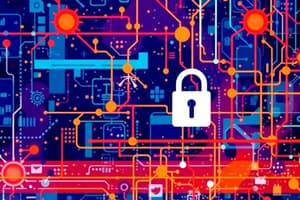Podcast
Questions and Answers
Broadband is often referred to as low-speed Internet.
Broadband is often referred to as low-speed Internet.
False (B)
Satellite Internet is mostly used in urban areas.
Satellite Internet is mostly used in urban areas.
False (B)
A network-attached storage (NAS) device allows for centralized data storage and access.
A network-attached storage (NAS) device allows for centralized data storage and access.
True (A)
Wi-Fi 4 or Wi-Fi 5 wireless devices have a maximum range of about 150 feet.
Wi-Fi 4 or Wi-Fi 5 wireless devices have a maximum range of about 150 feet.
All devices on a home network should use the latest Ethernet standard for the best efficiency.
All devices on a home network should use the latest Ethernet standard for the best efficiency.
Mobile broadband connects you to the Internet through 3G or 4G access.
Mobile broadband connects you to the Internet through 3G or 4G access.
An Internet connectivity plan is commonly referred to as a data plan.
An Internet connectivity plan is commonly referred to as a data plan.
An algorithm is a visual representation of patterns that describes what a program must do.
An algorithm is a visual representation of patterns that describes what a program must do.
Top-down design involves breaking a problem into high-level tasks and further refining those into subtasks.
Top-down design involves breaking a problem into high-level tasks and further refining those into subtasks.
Error handling is the process of converting inputs into proper outputs.
Error handling is the process of converting inputs into proper outputs.
In object-oriented analysis, classes refer to the categories of inputs the program is meant to solve.
In object-oriented analysis, classes refer to the categories of inputs the program is meant to solve.
Binary decisions can be answered with multiple choices beyond just yes or no.
Binary decisions can be answered with multiple choices beyond just yes or no.
A keylogger is a program that captures all mouse movements on a computer.
A keylogger is a program that captures all mouse movements on a computer.
A Trojan horse is a program that appears harmless but performs malicious actions in the background.
A Trojan horse is a program that appears harmless but performs malicious actions in the background.
A computer controlled by a hacker is called a guardian.
A computer controlled by a hacker is called a guardian.
In a denial-of-service (DoS) attack, legitimate users are denied access to a system due to overwhelming requests.
In a denial-of-service (DoS) attack, legitimate users are denied access to a system due to overwhelming requests.
A distributed denial-of-service (DDoS) attack comes from a single compromised computer.
A distributed denial-of-service (DDoS) attack comes from a single compromised computer.
Exploit kits are designed to fix vulnerabilities in software.
Exploit kits are designed to fix vulnerabilities in software.
A virus primarily aims to replicate itself and spread to other hosts.
A virus primarily aims to replicate itself and spread to other hosts.
Boot-sector viruses attach themselves to the master boot record of a hard drive.
Boot-sector viruses attach themselves to the master boot record of a hard drive.
Worms are dependent on host files to spread and execute.
Worms are dependent on host files to spread and execute.
E-mail viruses can use the victim's address book for distribution.
E-mail viruses can use the victim's address book for distribution.
Walls and large metal objects are common sources of interference with wireless signals.
Walls and large metal objects are common sources of interference with wireless signals.
Changing the SSID is one method for securing a wireless network.
Changing the SSID is one method for securing a wireless network.
Black-hat hackers are known for securing systems against vulnerabilities.
Black-hat hackers are known for securing systems against vulnerabilities.
Identity theft is considered the least financially damaging cybercrime for individuals.
Identity theft is considered the least financially damaging cybercrime for individuals.
A packet analyzer is used by hackers to monitor data packets traveling over the Internet.
A packet analyzer is used by hackers to monitor data packets traveling over the Internet.
Limit signal range is one method mentioned for enhancing wireless network security.
Limit signal range is one method mentioned for enhancing wireless network security.
Cybercrime encompasses actions that are not primarily conducted through the use of computers.
Cybercrime encompasses actions that are not primarily conducted through the use of computers.
Grey-hat hackers break into systems for malicious purposes only.
Grey-hat hackers break into systems for malicious purposes only.
Keeping router firmware up to date is not a recommended method for securing wireless networks.
Keeping router firmware up to date is not a recommended method for securing wireless networks.
Scareware is a type of malware that aims to make you believe your computer is infected with a virus.
Scareware is a type of malware that aims to make you believe your computer is infected with a virus.
Firewalls are only hardware devices designed to protect computers from hackers.
Firewalls are only hardware devices designed to protect computers from hackers.
Antivirus protection is usually included in comprehensive internet security packages.
Antivirus protection is usually included in comprehensive internet security packages.
A virus signature is a unique code that identifies a particular computer virus.
A virus signature is a unique code that identifies a particular computer virus.
Drive-by downloads affect approximately 1 in 10 web pages.
Drive-by downloads affect approximately 1 in 10 web pages.
Strong passwords should be at least twelve characters long and include a mix of uppercase, lowercase, numeric, and symbol characters.
Strong passwords should be at least twelve characters long and include a mix of uppercase, lowercase, numeric, and symbol characters.
Biometric authentication devices utilize personal characteristics such as fingerprints or iris patterns for authentication.
Biometric authentication devices utilize personal characteristics such as fingerprints or iris patterns for authentication.
Quarantining a virus involves deleting it immediately from the computer.
Quarantining a virus involves deleting it immediately from the computer.
Windows Firewall shows visual indications of its status to the user.
Windows Firewall shows visual indications of its status to the user.
Antivirus software is exclusively designed to protect computers from malware other than viruses.
Antivirus software is exclusively designed to protect computers from malware other than viruses.
Flashcards
Broadband
Broadband
A high-speed internet connection that provides faster speeds compared to dial-up or cellular access.
Cable Internet
Cable Internet
A type of high-speed internet connection where your data travels through cables, like those used for cable TV.
DSL Internet
DSL Internet
A type of high-speed internet connection that uses your existing phone line.
Fiber-optic Internet
Fiber-optic Internet
Signup and view all the flashcards
Router
Router
Signup and view all the flashcards
Switch
Switch
Signup and view all the flashcards
Wi-Fi
Wi-Fi
Signup and view all the flashcards
What are common sources of Wi-Fi signal interference?
What are common sources of Wi-Fi signal interference?
Signup and view all the flashcards
What is a wireless range extender?
What is a wireless range extender?
Signup and view all the flashcards
What is a security protocol for wireless networks?
What is a security protocol for wireless networks?
Signup and view all the flashcards
What is the SSID for a wireless network?
What is the SSID for a wireless network?
Signup and view all the flashcards
What is hacking?
What is hacking?
Signup and view all the flashcards
What is a black-hat hacker?
What is a black-hat hacker?
Signup and view all the flashcards
What is cybercrime?
What is cybercrime?
Signup and view all the flashcards
What is identity theft?
What is identity theft?
Signup and view all the flashcards
What is a packet analyzer?
What is a packet analyzer?
Signup and view all the flashcards
Keylogger
Keylogger
Signup and view all the flashcards
Trojan Horse
Trojan Horse
Signup and view all the flashcards
Backdoor programs & rootkits
Backdoor programs & rootkits
Signup and view all the flashcards
Zombie
Zombie
Signup and view all the flashcards
Denial-of-Service (DoS) attack
Denial-of-Service (DoS) attack
Signup and view all the flashcards
Distributed Denial-of-Service (DDoS) attack
Distributed Denial-of-Service (DDoS) attack
Signup and view all the flashcards
Botnet
Botnet
Signup and view all the flashcards
Exploit kit
Exploit kit
Signup and view all the flashcards
Virus
Virus
Signup and view all the flashcards
Boot-sector virus
Boot-sector virus
Signup and view all the flashcards
Firewall
Firewall
Signup and view all the flashcards
Scareware
Scareware
Signup and view all the flashcards
Antivirus software
Antivirus software
Signup and view all the flashcards
Virus signature
Virus signature
Signup and view all the flashcards
Quarantining
Quarantining
Signup and view all the flashcards
Inoculation
Inoculation
Signup and view all the flashcards
Drive-by download
Drive-by download
Signup and view all the flashcards
Biometric authentication
Biometric authentication
Signup and view all the flashcards
Strong password
Strong password
Signup and view all the flashcards
Network address translation
Network address translation
Signup and view all the flashcards
Algorithm
Algorithm
Signup and view all the flashcards
Flowchart
Flowchart
Signup and view all the flashcards
Binary Decision
Binary Decision
Signup and view all the flashcards
Top-Down Design
Top-Down Design
Signup and view all the flashcards
Object-Oriented Programming
Object-Oriented Programming
Signup and view all the flashcards
Study Notes
Chapter 7: Networking: Connecting Computing Devices
- Networking connects two or more computers to communicate
- Each device on a network is called a node
- Nodes can be computers, peripherals (printers, game consoles), or network devices (routers)
- Networks offer benefits like shared internet, printers, files, and communication, but setup can take time
Learning Objectives
- Describe computer networks and their advantages/disadvantages
- Explain network classifications by distance (PAN, LAN, HAN, MAN, WAN) and administration (client/server, peer-to-peer)
- Describe network transmission media (wireless, wired; e.g., UTP, coaxial, fiber-optic cables)
- Describe basic network hardware (network adapter, NIC, modem, router, switch)
- Describe the software necessary for networks (operating systems, specialized network operating systems)
- Summarize internet access methods (broadband, cellular, dial-up)
Networking Fundamentals
- Computer networks connect multiple computers to share resources
- A node is any device connected to a network
- Networks can share internet connections, printers, and files
Data Transfer in Networks
- Bandwidth is the maximum data transfer rate
- Throughput is the actual data transfer rate
- Units used to measure data transfer rates are Mbps (megabits per second) and Gbps (gigabits per second)
Network Architectures
- Networks are classified by distance:
- Personal Area Network (PAN)
- Local Area Network (LAN)
- Home Area Network (HAN)
- Metropolitan Area Network (MAN)
- Wide Area Network (WAN)
- Networks are also classified by administrative level:
- Client/server network
- Peer-to-peer (P2P) network
Network Components (Hardware)
- A node needs a network adapter (NIC)
- A modem translates signals for broadband connections
- Routers transfer data between networks
- Switches manage traffic within a network
Network Components (Software)
- Operating systems for P2P networks
- Client/server networks use specialized network operating systems (NOS)
Connecting to the Internet
- Broadband internet is most preferred
- Internet service providers (ISPs) provide internet access
Broadband Internet Connections
- Cable Internet
- DSL (digital subscriber line)
- Fiber-optic service
Connecting to the Internet (Wireless)
- Mobile broadband
- Mobile hotspots
- Wireless Internet service providers (ISPs)
- Data plans are needed for wireless internet access
Installing and Configuring Home Networks
- List all devices being used
- Use the latest network standards for best experience
- Consider having ISP provide newer router
Network Components
- Networks require a means of connecting nodes (e.g., cables or wireless technology)
- Special hardware allows nodes to communicate and send data
- Software runs networks
Transmission Media
- Transmission media establishes communication between network nodes
- Media can be wireless or wired
Wired Networks
- UTP cable: twisted copper wires surrounded by plastic
- Coaxial cable: single copper wire surrounded by plastic layers
- Fiber-optic cable: plastic or glass fibers
Network Components (Hardware)
- Network adapters (NIC)
- Modems
- Routers
- Switches
Network Components (Software)
- Operating systems for P2P networks and client-server networks
Securing Wireless Networks
- Use encryption and security protocols
- Change network name (SSID)
- Disable SSID broadcast
- Change default passwords
- Create strong passphrases
- Implement media access control
- Limit signal range
- Keep router firmware up to date
- Disable remote access
Identity Theft and Hackers
- Cybercrime: Criminal actions using computers, networks, and the internet.
- Cybercriminals: Individuals who perform these crimes.
- Common types: FBI-related scams, identity theft, non-delivery of merchandise, and advance fee fraud.
- Identity Theft: Criminals steal personal information to impersonate someone
- Scareware: Malicious software designed to scare users into paying for fake virus removal
- Hackers: Individuals who break into computer systems
- White-hat hackers: Ethical hackers who find vulnerabilities
- Black-hat hackers: Break into systems for illegal gain
- Grey-hat hackers: Break into systems to demonstrate skill or to repair breaches
- Zombies: Hackers' controlled computers
- Botnets: Large groups of zombie computers
- Trojan Horses: Malicious programs disguised as legitimate applications
- Exploit kits: Software that searches for vulnerabilities in servers
Computer Viruses
- Independent programs that run on computers
- Main goal: Replicate and spread through other files
- Can have secondary goals, like display annoying messages or delete files
- Classified by methods used to avoid detection
- Polymorphic viruses: Constantly change their code
- Multi-partite viruses: Infect multiple file types
- Stealth viruses: Hide by temporarily erasing their code
Online Annoyances
- Malware: Software with malicious intent
- Adware: Displays advertisements
- Spyware: Downloads with other software, tracks activities
- Keystroke logger: Records keystrokes
- Spam: Unwanted email
- Cookies: Small text files placed on hard drives when visiting websites
Social Engineering
- Social engineering: Using social skills to convince someone to reveal information
- Pretexting: Creating fake scenarios to trick people into revealing information
- Phishing: Luring people into revealing information by posing as a trustworthy entity (e.g., bank)
- Pharming: Planting malicious code on a computer to gather information
Restricting Access to Your Digital Assets
- Firewalls: Software and hardware to protect computers from hackers
- Antivirus software: Detects viruses and protects systems (e.g., Symantec, Trend Micro, Avast)
- Virus signatures: Specific portion of virus code for identification
- Quarantining: Isolating infected files
- Inoculation: Recording and storing data about computer files
- Drive-by downloads: Exploiting operating system weaknesses to infect computers
Authentication: Passwords and Biometrics
- Strong passwords are necessary to prevent unauthorized access to systems
- Biometric authentication uses unique personal characteristics such as fingerprints or facial recognition
Chapter 10: Behind the Scenes: Software Programming
- Tasks can be complex or repetitive, ideal for automation through programming
- Programming translates a task into commands that a computer executes
Life Cycle of a Program
- Problem statement: Defines tasks, goals, uses, data, and method
- Algorithm development: Steps to solve the problem, using flowcharts and pseudocode
- Coding: Translating an algorithm into a specific programming language, using an Integrated Development Environment (IDE)
- Debugging: Identifying and fixing errors in a program
- Testing and Documentation: Testing the program thoroughly and documenting it for maintenance
- General Availability: Making the program publicly accessible
Many Programming Languages
- Diverse languages exist to match diverse industries and tasks, like in financial services or manufacturing
- Language selection depends on available resources, needed speed, organizational structure, and application tasks
Chapter 11: Behind the Scenes: Databases and Information Systems
- Databases: Collections of related data that can be stored, sorted, organized, and queried
- Database advantages: Manage large amounts of data efficiently, share information, and promote data integrity
- Flat databases: Represented as lists or tables
- Relational databases: Organize data into tables, linking via common fields (relationships, primary/foreign keys)
- DBMS (Database Management System): Software running a database
Using Databases
- Data types: Different data types for storage (e.g., Short Text, Numbers, Currency)
- Field properties: Define data characteristics (e.g., size, default value, caption)
- Input forms: Control how new data is entered
- Data validation: Ensures data meets specific criteria
- Viewing and Sorting Data: Display and reorder data
- Extracting/Querying Data: Retrieve specific data
- Outputting Data: Display or transfer data to other applications
Data Warehousing and Storage
- Data mining: Analyzing and investigating data to identify patterns and trends
- Data mining techniques: Anomaly detection, association/affinity grouping, classification, clustering, estimation, visualization
Studying That Suits You
Use AI to generate personalized quizzes and flashcards to suit your learning preferences.
Related Documents
Description
This quiz covers essential topics in computer networking and programming, including types of Internet connections, data storage solutions, and fundamental programming principles. Test your knowledge on concepts like broadband, algorithms, and error handling. Perfect for students in computer science or information technology courses.




